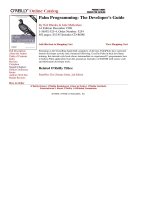OReilly Kerberos The Definitive Guide Dec 2003 ISBN 0596004036
Bạn đang xem bản rút gọn của tài liệu. Xem và tải ngay bản đầy đủ của tài liệu tại đây (239.41 KB, 7 trang )
10.2SmartCards
Traditionally,Kerberoshasreliedsolelyononeofthethree
factorsofauthentication,namely,somethingyouknow.As
discussedearlyoninChapter2,thesecurityofauthentication
systemscanbegreatlyenhancedbyrequiringmorethanone
factortograntauthentication.Smartcardsprovideanother
factor(whatyouhave),andsomeKerberosimplementations
supporttheuseofsmartcardsforinitialauthentication.
Theuseofsmartcardssolvesoneofthemostproblematic
issueswithKerberos;namelyitsdependenceonusersto
choose(andremember)goodpasswords.Traditionally,the
user'slong-termkeyisapassword,whichissomethingtheuser
mustchooseandmemorize.Thehumanbrainisnotoriously
pooratproducingandconsequentlyrememberingrandom
sequences,sopasswordsaretypicallysomethingeasily
rememberedbytheuser.Asaconsequence,passwordshave
lowentropy,andmostfalltodictionaryattacks.TheuseofpreauthenticationintheinitialAuthenticationServerexchange
mitigatesthisrisksomewhat,butadeterminedattackerwho
cansniffKerberosprotocolexchangesoverthenetworkcanstill
obtainencryptedmaterialonwhichtoperformadictionary
attack.
Inaddition,smartcardslimittheexposureofthesensitive
cryptographickeysusedthroughouttheKerberosprotocol.
Secretkeysstoredonmachineharddisks,suchaskeytabfiles,
arevulnerabletoattack.Eventhoughfilesystemprotectionis
designedtopreventunauthorizedusersfromreadingsensitive
files,softwarebugspersistthat,whenexploited,provide
attackerswithadministrativeaccesstotheentirecomputer,
includinganyencryptionkeysstoredwithin.
Smartcardssolvethisproblembystoringthekeymaterial
internallyonthesmartcarditself,andneverallowingthekey
materialtoleavethesmartcard.Instead,thesmartcardhas
enoughprocessingpowertoperformthecryptographic
functionsnecessarytogenerateandrespondtoKerberos
authenticationmessages.Storingthekeymaterialonthesmart
cardandsecuringthesmartcardfromunauthorizedaccess
meansthatanattackerwhohascontrolovertheuser's
workstationcanneverretrievetheencryptionkeysstoredinside
ofthesmartcard.ThisalsomitigatesTrojanhorsetechniques,
whereaprogrammasqueradingastheKerberosloginprogram
acquiresunwittingusers'passwords.
Sinceasmartcardisaphysicaldevice,itneedsaninterfaceto
thehostcomputerthesmartcardreader.Smartcardreaders
canconnecttothehostcomputerthroughseveralphysical
means,includingserial,USB,andforlaptops,PCMCIAslots.
Becauseoftherequirementforspecializedhardwareconnected
tothehostmachine,smartcardsarecurrentlyonlypractically
deployableinanorganization'snetwork.
Attacksonsmartcardsaredifficult,astheyaresmallphysical
devicesdesignedtoresistattack.Itrequiresadeterminedand
well-fundedadversarytocarryoutanattachonasmartcard.
Analysesofthesmartcard'spowerusageandtiminghavebeen
developedthatgreatlyreducethesearchspaceofpossible
encryptionkeysduringabrute-forceattackonakeystored
insideofasmartcard.Sincetheamountofcalculationsneeded
toperformencryptionalgorithmsdependsonthesizeand
contentoftheencryptionkey,theseattacksanalyzetheminute
differencesinpowerandtimeasthesmartcardperformsthese
operationsonvariousdata.Determinedattackerscannarrow
downthepossibleencryptionkeysbasedonthisanalysisand
ondetailedknowledgeofthealgorithmsinvolved.
Incidentally,thetimingattackhasbeendemonstratedasa
usefulagainstontraditionalsoftware-basedencryptionsoftware
aswell;asecurityadvisoryissuedin2003warnedusersthat
thepopularOpenSSLsoftwarepackageexposestiming
informationthatmaybeenoughforanadversarytoderivethe
privateencryptionkeysonaserver.Thisgoestoshowthatyou
canneverbeparanoidenoughwhenimplementing
cryptographicsystems.
10.2.1SmartCardsandtheKerberosProtocol
SmartcardsaretypicallydeployedaspartofaPublicKey
Infrastructure.Whenanewuserisenabled,apublickeypairis
generatedfortheuser,thepublickeyissignedbythe
certificateauthority,andtheresultingkeypairandcertificate
areplacedontothesmartcard'smemory.Thesmartcardis
thenissuedtotheuser.
WhentheuserusesasmartcardtoauthenticatetoaKerberos
realm,heinsertsthesmartcardintothesmartcardreader
connectedtohiscomputer.Thecomputerpromptstheuserfor
aPIN,whichisthensenttothesmartcard.ThePINunlocksthe
portionofthememorythathousestheuser'spublickeypair,to
lessenthedamageifthesmartcardislostorstolen.Oncethe
cardhasbeenunlockedinthisway,PKINITisusedtoobtain
initialticketsfortheuser.Theonlydifferenceisthattheactual
decryptionoftheinitialASresponsefromtheKDCisperformed
onthesmartcarditself,sothatthepublickeypairisnever
directlyaccessibletothehostcomputer.
Chapter2.PiecesofthePuzzle
Inthepreviouschapter,weexaminedtheideasandhistory
behindtheKerberosnetworkauthenticationsystem.Nowwe'll
begintodiscoverhowKerberosworks.Insteadofintroducing
theseconceptsasthey'reneededinthenextchapter,Ifeelthat
itiseasiertounderstandthenitty-grittydetailsofKerberos
whenyouhaveaworkingbackgroundinthesurrounding
terminology.Toemphasizetheimportanceofasolid
understandingintheseconcepts,Ihavesetasidethischapter
tointroduceyoutotheessentialconceptsandterminologythat
surroundtheuseandadministrationofaKerberos
authenticationsystem.Whileyoumaybefamiliarwithsomeof
theseconcepts,we'regoingtoexamineeachoneinturnand
describehowitrelatestoKerberos.
Kerberosisacomplexsystem,withmanyparts.Itrequiresthe
properfunctioningofmanyseparatesoftwarecomponents,and
witheachcomesasetoftermsandconceptsthatunderliethe
entiresystem.Acompleteintroductiontoalloftheseconcepts
iscriticaltotheunderstandingofthewhole.
Afterallofthesetermshavebeenintroduced,we'llfinishoffby
puttingallofthepiecestogetherandsetthestageforthe
detaileddescriptionoftheKerberosprotocolsinChapter3.For
thosewhosimplywishtoimplementaKerberosrealmandnot
worryaboutthelow-leveldetailsoftheprotocol,thischapter
willprepareyoutoskipdirectlytoChapter4.
Chapter3.Protocols
Theprevioustwochaptersintroducedthemajorconceptsthat
underlietheKerberosauthenticationsystem,andpresenteda
short,high-leveldiscussionofhowKerberosperformsitsmagic.
Thischaptercontinuesthatdiscussionbydrillingdownintothe
nitty-grittyoftheKerberosprotocolandpresentingitona
fundamentallevel.
Creatingaprotocolthatverifiestheidentityoftwoendpointson
anetworkgivenanunderlyingnetworkthatprovidesno
securityisadauntingtask.Kerberoswasdesignedunderthe
assumptionthatattackerscanread,copy,andcreatenetwork
trafficatwill.
Asyounowknow,therearetwoversionsofKerberosthatare
currentlyinwideusage:Kerberos4andKerberos5.This
chaptercoverstheprotocoldetailsofboth.Whiletheconcepts
andprotocoldesignofbothKerberos4and5areverysimilar,
therearemajordifferencesbetweentheirbyte-levelprotocol
andimplementation.
TheoriginalKerberos4protocolwasneverpublishedapartfrom
theKerberos4sourcedistribution.Assuch,theKerberos4
sourcecodefromMITistheonlyofficialdocumentationofthe
Kerberos4protocol.Ontheotherhand,thenewerKerberos5
protocolisextensivelydocumentedinRFC1510,andalso
throughaseriesofdocumentsthatarecollectivelyknownas
theKerberosClarifications.
ThebasicoperationofKerberosisbasedonapaperpublished
in1978byNeedhamandSchroeder.SincetheNeedhamand
SchroederprotocolisthebasisuponwhichKerberosisbuilt,we
willbeginourdiscussionthere.
Chapter4.Implementation
Thepreviouschaptersdiscussedtheconceptsandtheorythat
formthebasisoftheKerberosauthenticationsystem.Now,
armedwithasolidbackground,we'rereadytotackletheactual
implementationofaKerberosauthenticationsystemfromstart
tofinish.ThischapterpreparesyoutoinstalltheKerberosKDCs
inyournetworkandalsotheKerberoslibrariesonserversand
clientmachines.WewillcontinuetheprocessinChapter7by
detailinginstallationprocessesforKerberizedapplication
software.
Chapter7.Applications
EstablishingaKerberosrealmandcreatingKDCsforyourrealm
isonlythebeginningofcreatingaKerberos-based
authenticationinfrastructure.ToenjoythebenefitsofKerberos,
you,asthenetworkadministrator,alsohavetoinstallKerberosenabledservicesandclientsoftware.Thischapterillustrates
howtoenableKerberossupportinseveralpopularserver
packagesandthecorrespondingclientprograms.









